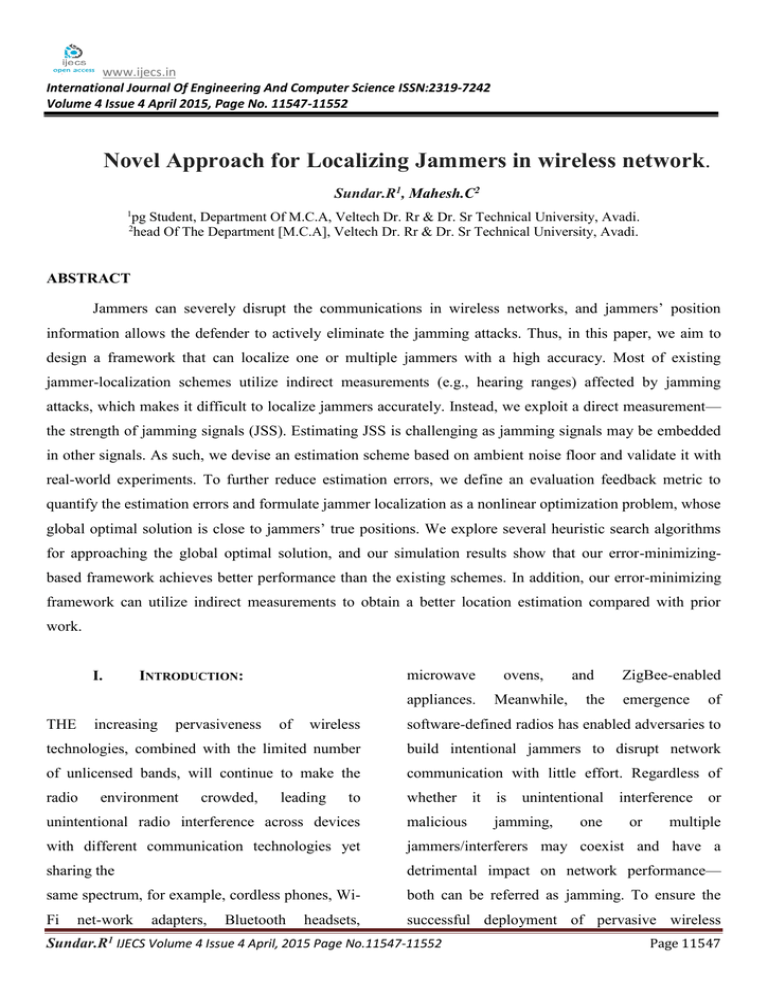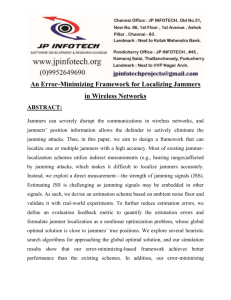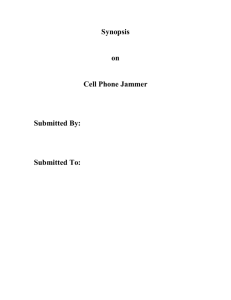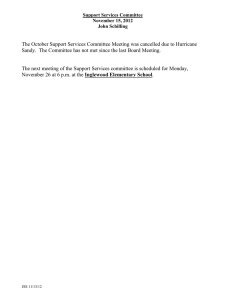www.ijecs.in International Journal Of Engineering And Computer Science ISSN:2319-7242
advertisement

www.ijecs.in
International Journal Of Engineering And Computer Science ISSN:2319-7242
Volume 4 Issue 4 April 2015, Page No. 11547-11552
Novel Approach for Localizing Jammers in wireless network.
Sundar.R1, Mahesh.C2
1
pg Student, Department Of M.C.A, Veltech Dr. Rr & Dr. Sr Technical University, Avadi.
head Of The Department [M.C.A], Veltech Dr. Rr & Dr. Sr Technical University, Avadi.
2
ABSTRACT
Jammers can severely disrupt the communications in wireless networks, and jammers’ position
information allows the defender to actively eliminate the jamming attacks. Thus, in this paper, we aim to
design a framework that can localize one or multiple jammers with a high accuracy. Most of existing
jammer-localization schemes utilize indirect measurements (e.g., hearing ranges) affected by jamming
attacks, which makes it difficult to localize jammers accurately. Instead, we exploit a direct measurement—
the strength of jamming signals (JSS). Estimating JSS is challenging as jamming signals may be embedded
in other signals. As such, we devise an estimation scheme based on ambient noise floor and validate it with
real-world experiments. To further reduce estimation errors, we define an evaluation feedback metric to
quantify the estimation errors and formulate jammer localization as a nonlinear optimization problem, whose
global optimal solution is close to jammers’ true positions. We explore several heuristic search algorithms
for approaching the global optimal solution, and our simulation results show that our error-minimizingbased framework achieves better performance than the existing schemes. In addition, our error-minimizing
framework can utilize indirect measurements to obtain a better location estimation compared with prior
work.
I.
microwave
INTRODUCTION:
appliances.
THE
increasing
pervasiveness
Meanwhile,
and
the
ZigBee-enabled
emergence
of
wireless
software-defined radios has enabled adversaries to
technologies, combined with the limited number
build intentional jammers to disrupt network
of unlicensed bands, will continue to make the
communication with little effort. Regardless of
radio
whether it
is
unintentional radio interference across devices
malicious
jamming,
with different communication technologies yet
jammers/interferers may coexist and have a
sharing the
detrimental impact on network performance—
same spectrum, for example, cordless phones, Wi-
both can be referred as jamming. To ensure the
Fi
successful deployment of pervasive wireless
environment
net-work
crowded,
adapters,
of
ovens,
leading
Bluetooth
to
headsets,
Sundar.R1 IJECS Volume 4 Issue 4 April, 2015 Page No.11547-11552
unintentional
one
interference or
or
multiple
Page 11547
networks, it is crucial to localize jammers, since
1. EvaluateMetric() has to define an appropriate
the locations of jammers allow a better physical
metric to quantify the accuracy of estimated
arrangement of wireless devices that cause
jammers’ locations.
unintentional radio interference, or enable a wide
2. MeasureJSS() has to obtain JSS even if it may
range
be embedded in regular transmission.
of
defense
strategies
for
combating
malicious jamming attackers.
3. SearchForBetter() has to efficiently search for
the best estimation.
II.
LOCALIZATION
FORMULATION:
Essentially, our jammer localization approach
works as follows: Given a set of JSS, for every
Algorithm
estimated location, we are able to provide a
1. Jammer Localization Framework
quantitative evaluation feedback indicating the
1: p ¼ MeasureJSS()
distance between the estimated locations of
2: z ¼ Initial positions
jammers and their true locations. For example, a
3: while Terminating Condition True do
small value of evaluation feedback indicates that
4: ez ¼ EvaluateMetricðz; pÞ
estimated locations are close to the true ones, and
5: if NotSatisfy(ez) than
vice versa. Although unable to adjust the
6: z ¼ SearchForBetter()
estimation directly, it is possible, from a few
7: end if
candidate locations, to select the ones that are
8: end while
closest to the true locations with high probability,
making searching for the best estimate feasible.
III.
NOVEL
APPROACH
Leveraging this idea, our jammer localization
LOCALIZING
approach comprises two steps: 1) JSS collection.
GREEDY ALGORITHM:
FOR
JAMMERS
WITH
Each boundary node locally obtains JSS.
2) Best estimation searching. Based on the
The
increasing
pervasiveness
collected JSS, a designated node will obtain a
technologies, combined with the limited number
rough estimation of the jammers’ positions. Then,
of unlicensed bands, will continue to make the
it refines the estimation by searching for positions
radio
that minimize the evaluation feedback metric. The
unintentional radio interference across devices
details are described in Algorithm 1. The search-
with different communication technologies yet
based jammer localization approaches have a few
sharing the same spectrum, for example, cordless
challenging subtasks:
phones,
environment
Wi-Fi
crowded,
network
of
wireless
leading
adapters,
to
Bluetooth
headsets, microwave ovens, and ZigBee-enabled
appliances. Meanwhile, the emergence of software
Sundar.R1 IJECS Volume 4 Issue 4 April, 2015 Page No.11547-11552
Page 11548
defined radios has enabled adversaries to build
regular network traffic. The commonly used
intentional
network
received signal strength (RSS) measurement
communication with little effort. Regardless of
associated with a packet does not correspond to
whether it
is
JSS. To overcome this challenge, we devise a
malicious
jamming,
jammers
to
disrupt
unintentional
one
interference or
or
multiple
scheme that can effectively estimate the JSS
jammers/interferers may coexist and have a
utilizing the measurement of the ambient noise
detrimental impact on network performance—
floor (ANF), which is readily available from many
both can be referred as jamming.
commodity devices (e.g., MicaZ motes). Our
experiments using MicaZmotes with multiple
To ensure the successful deployment of pervasive
sender receiver pairs confirm the feasibility of
wireless networks, it is crucial to localize
estimating JSS under various network traffic
jammers, since the locations of jammers allow a
conditions. With the ability to estimate JSS, it
better physical arrangement of wireless devices
appears that one may leverage existing RSS-based
that cause unintentional radio interference, or
localization algorithms designed for regular
enable a wide range of defense strategies for
wireless devices to localize jammers.
combating malicious jamming attackers. In this
work, we focus on localizing one or multiple
However, we consider jamming localization
stationary jammers. Our goal is to extensively
different for the following reasons:
improve the accuracy of jammer localization.
Current jammer localization approaches mostly
1) Most jammers start to disturb network
rely on parameters derived from the affected
communication after network deployment, which
network topology, such as packet delivery ratios ,
makes it infeasible to obtain a site survey of radio
neighbor lists , and nodes’ hearing ranges . The
fingerprints
use of these indirect measurements derived from
commonly used method for localization in an
jamming effects makes it difficult to accurately
indoor environment.
around
jammers
beforehand,
a
localize jammers’ positions.
2) No detailed prior knowledge about the
Furthermore, they mainly localize one jammer and
jammers’ transmission power is available.
cannot cope with the cases that multiple jammers
are located close to each other and their jamming
3) Multiple jammers with overlapped jamming
effects overlap. To address the limitation caused
areas
by indirect measurements of the jamming effect,
communication together, while attempting to hide
we propose to use the direct measurement of the
their true locations.
may
collude
and
disturb
network
strength of jamming signal (JSS). Localizing
jammers using JSS is appealing yet challenging.
To overcome these challenges and increase the
First, jamming signals are embedded in the
localization accuracy, we formulate the jammer
Sundar.R1 IJECS Volume 4 Issue 4 April, 2015 Page No.11547-11552
Page 11549
localization problem as a nonlinear optimization
We exploited path loss and shadowing phenomena
problem and define an evaluation metric as its
in radio propagation and defined an evaluation
objective function. The value of evaluation metric
metric that can quantify the accuracy of the
reflects how close the estimated jammers’
estimated
locations are to their true locations, and thus, we
evaluation metric, we formulated the jammer
can search for the best estimations that minimize
localization problem as an error-minimizing
the evaluation metric. Because traditional gradient
framework and studied several heuristic searching
search methods may converge to a local minimum
algorithms for finding the best solution. . Our
and may not necessarily yield the global
error-minimizing-based algorithms can localize
minimum, we adopt several algorithms that
multiple jammers simultaneously, even if their
involve stochastic processes to approach the
jamming areas overlap. Localizing in such a
global optimum.
scenario is known to be challenging.
In particular, we examined three algorithms: a
locations.
Leveraging
such
an
GREEDY ALGOIRITM
genetic algorithm (GA), a generalized pattern
search
(GPS)
annealing
algorithm,
(SA)
and
algorithm.
a
simulated
Our
extensive
simulation\ results show that our localization
error-minimizing framework not only can improve
the estimation accuracy of localizing one jammer
compared to prior work but also can estimate the
1 n length[s]
2 A {1}
3j 1
4 for i 2 to n
5 do if si âj
6 then A A
{i}
7j i
8 return A
positions of multiple jammers simultaneously,
making it especially useful for identifying
unintentional
radio\
interference
caused
by
multiple wireless devices or a few malicious and
collaborative jammers. We summarize our main
contributions as follows: . Estimating JSS is
challenging because the jamming signals are
embedded in the regular signals. To the best of
our knowledge, our work is the first that directly
utilizes the JSS to localize jammers. Our results
IV.
using direct measurements (e.g., JSS) exhibit
MEASURING
JAMMING
SIGNALS
significant improvement compared with those
using
indirect
ranges). .
measurements
(e.g.,
hearing
RSS is one of the most widely used measurements
in localization. For instance, a WiFi device can
estimate its most likely location by matching the
Sundar.R1 IJECS Volume 4 Issue 4 April, 2015 Page No.11547-11552
Page 11550
measured RSS vector of a set of WiFi APs with
algorithms to the prior work by Liu et al. [3], i.e.,
pretrained RF fingerprinting maps or with
the adaptive LSQ algorithm. We developed a
predicted RSS maps constructed based on RF
simulator in Matlab. We simulated the underlying
propagation models. However, obtaining signal
radio propagation according to the log-normal
strength of jammers (JSS) is a challenging task
shadowing model and used GA, GPS, and SA
mainly because jamming signals are embedded in
functions provided in the global
signals transmitted by regular wireless devices.
optimization toolbox in Matlab. To make a fair
The situation is complicated because multiple
comparison, we set the parameters of the
wireless devices are likely to send packets at the
shadowing model to the same values as the ones
same time, as jamming disturbs the regular
used in the prior work by Liu et al. We compared
operation of carrier sensing multiple accesses. For
the
the rest of this paper, we refer the regular nodes’
configurations, including node densities, jammer’s
concurrent packet transmissions that could not be
transmission power, the standard deviation of
decoded as a collision. While it is difficult, if ever
random attenuation, and the number of jammers.
possible, to extract signal components contributed
In addition, we examined our error-minimizing
by jammers or collision sources, we discover that
framework
it is feasible to derive the JSS
hearing ranges [15]) are used. A hearing range is
based on periodic ambient noise measurement. In
the area within which a node can successfully
the following sections, we first present basics of
receive and decode packets, and it is affected by
ambient noise with regard to jamming signals and
the jammers’ locationsand transmission power.
algorithms
in
when
a
variety
indirect
of
network
measurements(i.e.,
then introduce our scheme to estimate the JSS.
Finally, we validate our estimation schemes via
VI.
CONCLUSION:
real-world experiments.
In this work, we addressed the problem of
V.
PERFORMANCE
localizing jammers in wireless networks, aiming
VALIDATION
to extensively reduce estimation errors. The
jammers could be several wireless devices causing
In this section, we evaluated the performance of
unintentional radio interference or malicious
our jammer localization approaches that utilize the
colluding jamming devices who coexist and
error-minimizing framework. Detailed evaluations
disturb the network together. Most of the existing
are presented in the supplementary file, available
schemes for localizing jammers rely on the
online.
search
indirect measurements of network parameters
algorithms for finding the best estimation of
affected by jammers, for example, nodes’ hearing
jammers’ position: a GA, a GPS algorithm, and an
ranges, which makes it difficult to accurately
SA algorithm; and compared those three
localize jammers. In this work, we localized
We
studied
three
heuristic
jammers
Sundar.R1 IJECS Volume 4 Issue 4 April, 2015 Page No.11547-11552
by
exploiting
directly
the
JSS.
Page 11551
Estimating JSS is considered challenging because
they are usually embedded with other signals. Our
estimation scheme smartly derives ANFs as the
JSS
utilizing
the
available
signal
strength
measuring capability in wireless devices. The
scheme samples signal strength regardless of
[6] A. Wood, J. Stankovic, and S. Son, “JAM: A
Jammed-Area Mapping Service for Sensor
Networks,” Proc. 24th IEEE Int’l Real-Time
Systems
Symp.,
2003.
516
IEEE
TRANSACTIONS ON PARALLEL AND
DISTRIBUTED SYSTEMS, VOL. 25, NO. 2,
FEBRUARY 2014 Fig. 8. Performance of all
algorithms that use indirect measurements (e.g.,
hearing ranges).
whether the channel is busy or idle and estimates
the ANF by filtering out regular transmission (if
any) to obtain the JSS. We implemented an
estimation
scheme
on
MicaZ
motes.
Our
experiment involving three jammers show that our
estimation scheme can accurately derive the JSS
from the measurements of ANF under various
traffic scenarios.
REFERENCES:
[1] K. Pelechrinis, I. Koutsopoulos, I. Broustis,
and S.V. Krishnamurthy, “Lightweight Jammer
Localization in Wireless Networks: System
Design and Implementation,” Proc. IEEE
GLOBECOM, 2009.
[2] H. Liu, Z. Liu, Y. Chen, and W. Xu,
“Determining the Position of a Jammer Using a
Virtual Force Iterative Approach,” Wireless
Networks, vol. 17, pp. 531-547, 2010.
[3] Z. Liu, H. Liu, W. Xu, and Y. Chen,
“Exploiting Jamming-Caused Neighbor Changes
for Jammer Localization,” IEEE Trans. Parallel
and Distributed Systems, vol. 23, no. 3, pp. 547555, Mar. 2012.
[7] W. Xu, W. Trappe, Y. Zhang, and T. Wood,
“The Feasibility of Launching and Detecting
Jamming Attacks in Wireless Networks,” Proc.
ACM MobiHoc, 2005.
[8] A. Goldsmith, Wireless Communications.
Cambridge Univ. Press, 2005.
[9] T. Rappaport, Wireless Communications—
Principles and Practice. Prentice-Hall, 2001.
[10] P. Bahl and V.N. Padmanabhan, “RADAR:
An In-Building RFBased User Location and
Tracking System,” Proc. IEEE INFOCOM, 2000.
[11] J. Yang, Y. Chen, and J. Cheng, “Improving
Localization Accuracy of RSS-Based Lateration
Methods in Indoor Environments,” Ad Hoc and
Sensor Wireless Networks, vol. 11, nos. 3/4, pp.
307-329, 2011.
[12] D. Goldberg, Genetic Algorithms in Search,
Optimization and Machine Learning. Addison
Wesley, 1989.
[13] E. Polak, Computational Methods in
Optimization: A Unified Approach. Academic
Press, 1971.
[4] H. Liu, Z. Liu, Y. Chen, and W. Xu,
“Localizing Multiple Jamming Attackers in
Wireless Networks,” Proc. 31st Int’l Conf.
Distributed Computing Systems (ICDCS), 2011.
[5] T. Cheng, P. Li, and S. Zhu, “Multi-Jammer
Localization in Wireless Sensor Networks,” Proc.
Seventh Int’l Conf. Computational Intelligence
and Security (CIS), 2011.
Sundar.R1 IJECS Volume 4 Issue 4 April, 2015 Page No.11547-11552
Page 11552


